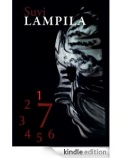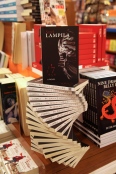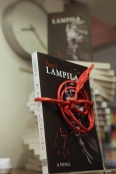I have just finished Walter Isaacson’s hefty book Einstein: His Life and Universe. It was a real page turner. Isaacson has taken the general relativity, and the man behind it, to tell a compelling story. Surprisingly, not even the calculations Einstein wrote down on his death bed leave you as baffled as does his personal life, particularly his relationship with his first wife and children. I am incapable of enjoying even a biography without a compulsion to interpret everything I read.
Lack of evidence appears to have made Isaacson cautious to openly support any theory on what happened to Albert Einstein’s and Mileva Maric’s illegitimate daughter Lieserl. On the surface it looks like he dutifully lists the different theories, the most popular one being that Lieserl died of scarlet fever as a toddler. Another theory favored by Robert Schulmann of the Einstein Papers Project, according to Isaacson, is that Mileva’s close friend Helene Savic adopted Lieserl. Also according to Isaacson, Helene Savic brought up a girl named Zorka, who was blind, never married, was shielded by her nephew from interviews and died in the nineties. Isaacson is careful to state that Zorka’s nephew, Milan Popović, favors the theory that Einstein’s daughter died of scarlet fever, but then goes as far as to state that Zorka’s relatives have not provided any proof, such as a birth certificate, to prove Zorka was not Lieserl.
Conveniently, most of the correspondence between the women from this time period has been destroyed by Mileva herself and Zorka’s protective family. Only few letters between Einstein and Mileva remain that reveal Lieserl even existed. In one of them it was discussed that their daughter might have suffered some lasting effect due to scarlet fever, which Isaacson speculates could be blindness. Several chapters later Isaacson mentions in passing Mileva’s sister by name – Zorka. There is nothing like a princess that inspires people to name their daughter (I’ve done it myself twice) so Zorka was by no means uncommon name in Serbia at the time. Still something in me gravitates toward the tragic and poetic theory, which Isaacson appears to support in between the lines.
The adopted by a family friend theory would certainly explain several peculiarities in Mileva’s and Einstein’s life. While Mileva was pregnant, and immediately after giving birth, Einstein was thrilled, and nothing suggested that they would give up the baby. Almost nothing: two months before giving birth, Mileva wrote to Einstein about telling her friend: “I don’t think we should say anything about Lieserl yet.” and “We must now treat her very nicely. She’ll have to help us in something important, after all.” Isaacson speculates this could be a cryptic hint that Mileva and Einstein hoped their friend would take custody of their child.
After Lieserl was born something clearly changed. It could have been Einstein’s new position at the patent office, like Isaacson suggests, or that Lieserl was born with a birth defect, or something else that made Einstein and Mileva decide not to raise Lieserl themselves. At this point, I was no longer able to help myself; I let my imagination take over.
Suppose Mileva didn’t want to give her baby up for adoption, even under the circumstances, but didn’t want her family to raise her child either, as later on Lieserl would learn who her parents were, so she turned to her friend Helene Savic for help. The condition of the unofficial adoption would be that Mileva would be able to stay in contact with her daughter through Helene, but Lieserl, and no one else for that matter, would never learn who her true parents were. Hence their letters were deliberately destroyed. Suppose Helen renamed Lieserl, Zorka, possibly upon Mileva’s request. After all it was her sister’s name, the sister whom she confided in about the pregnancy. One thing is certain though, Lieserl was a family secret, and I have little doubt it consumed Mileva until the day she died.
Why would Mileva keep the letters written by Einstein that revealed they had a daughter? To remind herself that their daughter was loved once, however briefly, a romantic would say. As an insurance, something she could use to blackmail Einstein into marriage, and later for financial support, a cynic would say. All of the above, and to protect Zorka in the event it would come to light that Einstein and Mileva had a daughter they had given up for adoption. Nothing is as convincing as admitting to a secret in order to hide another one.
And nothing is more lucrative than to cherry-pick evidence to support your own theory. All is well except there was no blind girl named Zorka, unless Helene Savic had three daughters. She did, however, have a daughter named Zora who was born the same year Lieserl is supposed to have died. Zora eventually married and had children. If someone was blind, it is unlikely it was Zora, as in the family picture she is the one looking into the camera, but her sister, who was born the same year as Lieserl, stares slightly off camera. I could be mistaken that there was in fact Zorka at the Savic household, but she wasn’t listed in the family tree, and therefore Milan Popović, the author of In Albert’s shadow, is not her protective nephew.
Walter Isaacson’s latest biography, on Steve Jobs, will be released today. I hope this time around Isaacson won’t let the apple fall too far of the tree.

 Amazon
Amazon Bookazine
Bookazine Dymocks
Dymocks Kapok
Kapok
A very interesting fourth theory. Tim, could you post the rest of the article as a comment?
In his later years Albert Einstein came to be considered a secular saint. His younger years were different.
Three years ago I published a research paper on the real-life mystery of Einstein’s illegitimate daughter titled ‘A Vital Detail In The Story of Albert Einstein’ (http://alberteinsteinmystery.wordpress.com/). Now my ‘Fourth Theory’ on her fate forms the basis of the new Sherlock Holmes novel –
Sherlock Holmes And The Mystery of Einstein’s Daughter
In late 1903 Albert Einstein’s illegitimate daughter ‘Lieserl’ disappears without trace in Serbia aged around 21 months. As Holmes exclaims in ‘the Mystery of Einstein’s Daughter’, ‘the most ruthless effort has been made by public officials, priests, monks, friends, relatives and relatives by marriage to seek out and destroy every document with Lieserl’s name on it. The question is – why?’
‘Lieserl’s fate shadows the Einstein legend like some unsolved equation’ Frederic Golden Time Magazine
Sherlock Holmes And The Mystery of Einstein’s Daughter is available at http://www.mxpublishing.co.uk/engine/shop/product/9781780925721 (re. review copies contact Steve Emecz at mxpublishing@btinternet.com) or http://www.amazon.co.uk/Sherlock-Holmes-Mystery-Einsteins-Daughter/dp/1780925727
Tim Symonds was born in London. He grew up in Somerset, Dorset and Guernsey. After several years working in the Kenya Highlands and along the Zambezi River he emigrated to the United States. He studied in Germany at Göttingen and at the University of California, Los Angeles (UCLA), where he graduated Phi Beta Kappa in Political Science. Sherlock Holmes And The Mystery Of Einstein’s Daughter was written in a converted oast house near Rudyard Kipling’s old home Bateman’s in Sussex and in the forests and hidden valleys of the Sussex High Weald.
The author’s other detective novels include Sherlock Holmes and The Dead Boer at Scotney Castle and Sherlock Holmes and The Case of the Bulgarian Codex.
He is a Fellow of the Royal Geographical Society.
Life spares none. And none is born matured. No one is so pure that they did not sell a small trust to get to get “that”. Passion and beliefs are just two of the madness. It takes a little honesty to look back in your own life to see what values you had to be compromised.